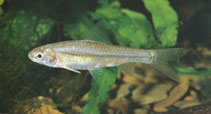| Family: |
Cyprinidae (Minnows or carps), subfamily: Smiliogastrinae |
| Max. size: |
8 cm TL (male/unsexed) |
| Environment: |
benthopelagic; freshwater |
| Distribution: |
Africa: Lake Malawi, Lake Rukwa, Wawi and Mkata Rivers (Ref. 2801). Also Rufiji-Ruaha system (Ref. 27292). |
| Diagnosis: |
Dorsal spines (total): 0-0; Dorsal soft rays (total): 11-12; Anal spines: 0-0; Anal soft rays: 7-9. Description: Small and inconspicious Enteromius species; body moderately elongate with a slender caudal peduncle (Ref. 27292). Snout rounded and terminate to subterminate; two pairs of barbels; eye as long as or a little bit longer in diameter than length of snout (Ref. 27292). Dorsal fin with 3 unbranched and 8-9 branched rays; anal fin with 2-3 unbranched and 5-6 branched rays; pectoral fin with 1 unbranched and 13-15 branched rays; pelvic fin with 1-2 unbranched and 7-8 branched rays; dorsal-fin origin slightly in front of or above pevic fins; dorsal fin relatively high; last simple dorsal ray long, smooth and flexible, not serrated posteriorly; hinder margin of dorsal fin slightly concave; caudal fin deeply forked, lobes pointed (Ref. 27292). Lateral line moderately curved downwards; lateral line scales 28-33; 4.5 scales above and 2.5 scales below lateral line; 12 scales around caudal peduncle (Ref. 27292, 122753). Colouration: The overall colour is that of a light brown, a little bit darker on the back and lighter to whitish or even silvery on the belly; especially on the back, each scale has a dark brownish margin; on the flanks of the body there is a silverish sheen which becomes even more prominent after preservation of the fish; in life, there is a dark brownish to greyish narrow band along the sides which runs from the upper gill cover to the caudal peduncle; this lateral streak, which frequently has a golden hue, is prominent in most specimens in only its last two thirds and often fades out in front of the dorsal fin, but it always is well marked in preserved specimens; fins brownish to transparent with the borders dark edged, especially in the dorsal fin; the lateral line pores of the first scales show some darkish pigments (Ref. 27292). |
| Biology: |
Found in shallow, sandy and vegetated areas. Feeds on insect, weeds and vegetable debris (Ref. 5595). |
| IUCN Red List Status: |
Least Concern (LC); Date assessed: 04 May 2018 Ref. (130435)
|
| Threat to humans: |
harmless |
| Country info: |
|
Source and more info: www.fishbase.org. For personal, classroom, and other internal use only. Not for publication.

